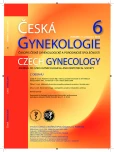Dehiscence of laparotomy after hysterectomy – wound management
Authors:
D. Karasová 1; M. Haško 2; K. Žiaková 1; P. Žúbor 2; A. Mikolajčík 3
Authors‘ workplace:
Ústav ošetrovateľstva JLF UK, Martin, Slovensko, vedúca pracoviska doc. Mgr. K. Žiaková, PhD., mim. prof.
1; Gynekologicko-pôrodnícka klinika, JLF UK a UNM, Martin, Slovensko, prednosta prof. MUDr. J. Danko, CSc.
2; Chirurgická klinika JLF UK a UNM, Martin, Slovensko, prednosta doc. MUDr. D. Mištuna, PhD., mim. prof.
3
Published in:
Ceska Gynekol 2012; 77(6): 486-491
Overview
Authors of the paper present prospective case report about nursing process and healing of extensive dehiscence of middle lower laparotomy wound in patient after surgical procedure for endometrial carcinoma. The aim of the paper is to describe, analyse and evaluate the process of complicated postoperative wound healing using negative pressure and moist therapy. They emphasize importance of cooperation between particular departments in complicated postoperative wound therapy management. They point out using new and easily available techniques and methods, risk factors elimination and maintenance of the factors that have a positive influence on wound healing.
Key words:
postoperative wound dehiscence, negative pressure wound therapy, moist therapy, case report.
Sources
1. Alexis, C. Holistic assessment and management of a complex wound. In Primary Intention., [online], 6/2006, 14, 2, p. 82–84. [23.11.2009]. Dostupné na: www.awma.com.au/journal/library/1402_04.pdf
2. Baherestani, MM., Gabriel, A. Use of negative pressure wound therapy in the management of infected abdominal wounds containing mesh: an analysis of outcomes. Int Wound J, 2011, 8, p. 118–125.
3. Blank, I. Wundversorgung und Verbandwechsel. Stuttgart: W. Kohl-hammer GmbH, 2007, 201 S.
4. Borgquist, O., et al. Wound edge microvascular blood flow during negative pressure wound therapy: examining the effects of pressures from −10 to −175 mmHg. Plast Reconstr Surg, 2010, 125, p. 502–509.
5. Bounovas, A., et al. Management of abdominal wound dehiscence with porcine dermal collagen implant: Report of case. 2008, [citované 24.10.2011]. dostupné na: http://www.o-wm.com/content/management-abdominal-wound-dehiscence-with-porcine-dermal-collagen-implant-report-a-case?page=0,0
6. Braumann, CH., et al. Komplieziert heilende Wunden und moderne Behandlungsstrategien. Perioperative Med, 2010, 2, S. 5–16.
7. Carlson, JW., et al. Multidisciplinary panel discussion of a gynecologic oncology patient: Preventing wound complications. Gynecol Oncol, 2008, 111, p. 98–100.
8. Daumann, S. Woundmanagement und Wounddokumentation. Stuttgart: W. Kohlhammer GmbH, 2009, 145 S.
9. Fonder, MA., et al. Treating the chronic wound: A practical approach to the care of nonhealing wounds and care dressings.J Am AcaD Dermatol, 2008, 58, 2, p. 185–206.
10. Germann, G. Kompendium rán a jejich ošetřování. Veverská Bítýška: Hartmann-Rico, 2002, 123 s.
11. Gillitzer, R. Modernes Wundmanagement. Hautarzt, 2002, 53, 2, S. 130–147.
12. Grofová, Z. Biologie rany. Čes geriatric Rev, 2006, 3, s. 157–162 [online]. [citované dňa 11.1.2012], dostupné na: http://www.geriatrickarevue.cz/
13. Guo, S., DiPietro, LA. Factors affecting wound healing. J Dental Res, 2010, 89, 3, p. 219–229, [online]. [citované dňa 30.10.2011], dostupné na: http://jdr.sagepub.com/content/89/3/219
14. Kitzinger, H., et al. Chirurgisches Debridement. In Manual der wundheilung. Wien: Springer-Verlag. 2007, S. 53–56.
15. Lee, DL., et al. Negative pressure wound therapy: an adjuvant to surgical reconstruction of large or difficult skin and soft tissue defects. Int Wound J, 2011, 8, p. 406–411.
16. Masumoto, K., et al. Successful treatment of an infected wound in infants by a combination of negative pressure wound therapy and arginine supplementation. Nutrition, 2011, 27, p. 1141–1145.
17. Mecott, G., et al. The role of hyperglycemia in burned patients: evidence based studies. Shock, 2010, 33, 1, p. 5–13.
18. Nugent, EK. Wound complications after gynecologic cancer surgery. Gynecol Oncol, 2011, 121, p. 347–352, [citované dňa 2-22-2012] dostupné na: journal homepage: www.elsevier.com/locate/ygyno
19. Panfil, ME., Schröder, G. Pflege von Menschen mit chronischen Wunden. 2. ed., Kösel: Verlag Hans Huber, Germany, 2010, 607 S.
20. Probst, W., Vasel-biergans, A. Wundmanagement. 2. ed., Stutt-gart: W. Kohlhammer, 2010, 527 S.
21. Siman, J., et al. Princípy chirurgie, Bratislava: SAP – Slovak Akademic Press, 2007, 923 s.
22. Smolár, M., et al. Meticilín-rezistentný Staphylococcus aureus (MRSA) v chirurgii. Slov Chirurgia, 2009, 6, 3, s. 13–15.
23. Stryja, J. Repetitorium hojení ran. 2. vyd. Praha: Vydavateľstvo GEUM, 2011. 371 s.
24. Wild, T., et al. Basics in nutrition and wound healing. Nutrition J, 2010, 26, p. 862–866.
Labels
Paediatric gynaecology Gynaecology and obstetrics Reproduction medicineArticle was published in
Czech Gynaecology

2012 Issue 6
Most read in this issue
- Monochorionic biamniotic twins with a common yolk sac in the first trimester ultrasound scan – is there a higher risk of a congenital defect?
- Homebirth in Czech Republic
- Conservative method in treatment of placenta accreta – two case reports
- Dehiscence of laparotomy after hysterectomy – wound management
